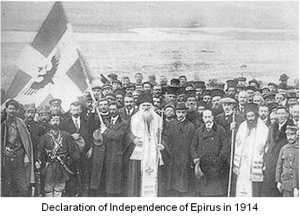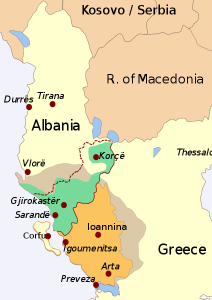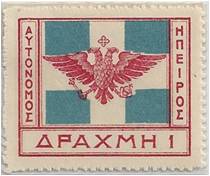ALBUM – view my Autonomous Epirus Album
Fast Facts
Region: Greece / Balkans
Group: Balkan countries
Classification: Revolutionary Government
Prior Regime: Greek administration of Epirus
Key Dates:
1912, Nov 18 – Chimarra revolted against the Ottomans
1914, Feb – Greeks withdraw from Northern Epirus
1914, Feb – Revolution and independent Epirus was declared
1914, Mar – Protocol of Corfu, autonomy of Epirus was agreed under Albanian sovereignty
1914, Nov – World War 1 begins and again Greece occupy Northern Epirus
Following Regime: Greek occupation of North Epirus
Scott Catalogue: (Epirus) # 1-41
Pick Catalogue: none
History

During the First Balkan War (1912-1913), which pitted the Balkan League of Serbia, Greece, Montenegro and Bulgaria against the Ottoman Turks, the people of Chimarra (today Himarë) lead by Spyros Spyromilios revolted and expelled the Ottoman forces in order to join Greece. For the balance of the war, Epirus was under Greek administration. Afterwards, the northern part of Epirus was awarded to a newly created Albanian state, and in early 1914, Greek troops withdrew from the region.

The Autonomous Republic had a very short lifespan. World War 1 broke out in July, 1914, and in September Albania collapsed into chaos. This caused the Greeks to send forces into Northern Epirus, to re occupy the territory. The Autonomous Republic of Epirus, ceased to exist. During the war, the region was occupied by the Greeks, the Italians and subsequently the French. At the end of the war, Northern Epirus was awarded to Greece, however following the Greco-Turkish war in 1924, and at the insistence of the Italian’s, Northern Epirus again became part of Albania, where it remains today.
Stamps
 ALBUM
ALBUM
Collecting stamps from this short lived republic tell an interesting story. As the fledgling nation began, a series of local stamps were issued in Chimarra on Feb 1914. The set of four featured a double-headed eagle along with a skull and crossbones. The inscription on the stamps translates as: “Greek Autonomous Epirus – Freedom or Death – Defend our Country”. Hand stamped, they were issued with a control mark consisting of a blue oval containing the Greek letters “SP”, representing “Spiromilios”, the revolutionary commander at Chimarra. Only a small number of these stamps were issued and are rare and expensive. The “Chimarra Issues” have been extensively reprinted and counterfeited, so all copies should be considered fake unless properly expertised.
The first “official” stamps of the Provisional Government of North Epirus were issued between Feb-Apr 1914. The set of 8 stamps featured an infantryman aiming his rifle, as others look on. The 10 and 25 lepta denominations (issued in February) were inscribed “ΗΠΕΙΡΟΣ”, meaning EPIRUS, while the rest of the set (issued in March-April) added the word “ΑΥΤΟΝΟΜΟΣ” to read “AUTONOMOUS EPIRUS”. On 28 August, 1914, a second set of stamps were issued by the government featuring the flag of Epirus. Two of the values, 25l and 40l were also overprinted “ΚΟΡΥΤΣΑ” in dark blue at the town of Koritsa. Both of these sets were issued as serrate roulette instead of standard perforations, and are readily available and affordable for collectors.
A third definitive set was released on 10 October, 1914 at Chimarra, which consisted of Greek Stamps overprinted “ΕΛΛΗΝΙΚΗ // 1914 // ΧΕΙΜΑΡΡΑ”, translated Greek // 1914 // Chimarra. Some of these issues also included a small monogram with the Greek letters SS, standing for S. Spiromilios. As with the first Chimarra issues, counterfeits are very common.
Additionally, at least 6 sets of cinderellas were issued, mostly for propaganda purposes.
Banknotes
none
Links
Postage Stamps of North Epirus from Wikipedia
History of Epirus from Wikipedia




